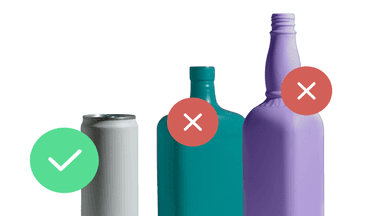The majority of product ideas fail at the early stages. Oftentimes they fail because the actual idea wasn’t good enough. But why didn’t the company find out the idea didn’t have legs sooner? Because they didn’t validate the product with the potential consumer.
You’ve likely heard the story of Google Glass, an experimental project led by Google, that was one of the biggest hypes (and, probably, one of the company’s biggest flops) back in 2013. Google Glass was supposed to be a revolutionary gadget straight out of sci-fi movies, able to show information to the user right in their field of vision.

But why did the project tank? Well, even though Google Glass was a cool new product, it didn’t really serve a specific purpose. The inventors couldn’t validate to potential customers why the gadget needed to exist. And so the product was pulled from production.
While the story of Google Glass might end here, we believe it demonstrates the value of product validation, or looked at a different way, the risk of not validating ideas along the way. In this article, we compiled 3 different ways you can assess the viability of your product idea before its launch.
Why you need product validation
The product validation process (which is part of concept validation research) helps you determine if there is a genuine need for your product in the market.
Whether you are a startup developing new products or a large brand looking to build on your existing product portfolio, product validation will help you understand if your consumer is interested in your idea and if you’re likely to have a profitable and successful product.
When you assess your ideas before launch you don’t waste time and money on a product that is not a good fit for your target audience. Which means that product validation will help you identify your customer’s pain points, as well as give you confidence that you’re building a product that will entice paying customers. It’s a win-win situation either way!
Not convinced on why product validation should be part of your product development process? Read this.
How to validate a product
1. Run a concept validation test

Concept validation surveys are a great way to forecast how your product idea will perform. Since you will be sending the survey to an audience that matches that of your prospective customers, you are likely to get quality data on their attitudes and reactions towards your product.
Civil Pours, a growing RTD cocktail brand, needed to figure out what kinds of cocktails are likely to drive the most demand. Upsiide’s idea screening methodology helped them deliver their value proposition to respondents, identify products that have the most potential and choose drink options that worked well together in the product mix.
Read Civil Pours’ full story to learn how they validated their product ideas with Upsiide.
A concept validation questionnaire can have different angles and areas of focus.
Usage & attitudes
If you are interested in better understanding your target market, you may want to do usage & attitudes research within your concept validation study.
With this type of market research, you can answer these questions:
What does my customer know about my category, brand, or competitors?
How would they use my product?
Are there any customer segments that may use my product more often?
Are there any customer segments that would be willing to spend more on my product?
Competitive analysis
This type of research helps you understand the competitive landscape your product fits into, learning if there are any brands that you may compete with.
If you find out about any competitive products that are similar to yours, learn more about them! Those products were likely already validated, so you will know if there is a market demand for your idea. Plus, you’ll have a head start to make your final product even better.
Some things you might want to ask yourself:
Are there any other competitive products that my customer uses? If so, which?
Are those competitive products similar to mine? How are they different?
How does my customer choose which product they will buy in the end?
Upsiide is the perfect tool for validating product ideas against your competition. See our platform in action and start building your first survey now.
Product-mix analysis
Whether you’re a brand with several existing products or an entrepreneur about to kickstart a whole line of products, product-mix analysis is your friend.
These are some questions product-mix analysis will answer:
What is the optimal mix of brands or variants to most efficiently maximize potential penetration?
What unit share or volume will my product mix offer?
If I add another product to the mix, how much of the sales volume will be incremental vs. cannibalistic?
2. Talk to your prospective customers

What’s a better way to conduct market validation research than asking your customers or prospective customers for their feedback in-person? Here are some ways to do just that:
Local events and trade shows - find out where your target audience spends their time and meet them where they are, gathering first-hand user feedback from potential customers.
Existing clients - if you already have a few paying customers, ask them what they think about the new product idea you’re developing. It’s worth noting that it makes sense for the person asking for this intel sits outside of sales or customer success; you want your customers to feel comfortable being as honest as possible.
In-person interviews - this is one of the most useful types of research for many businesses. Ask interviewees about their preferences, behaviour and pain points. Understand how they shop and what products they use. Finally, create hypotheses based on the feedback and use them to feed into the market validation process.
3. Launch a crowdfunding campaign

Crowdfunding is great in many ways. You can see if there’s a market demand for your product idea and you are also motivated to work harder to reach a specific goal.
It’s pretty easy to start a crowdfunding campaign today thanks to services like Indiegogo and Kickstarter. You can quickly create an account and landing page for your product, share it all over social media and track all pre-orders. Reach out to potential clients, put them in your email list and keep the conversation about your product going.
The right way to find a winning product idea is not that straightforward
It takes time to land on a winning idea, refine it, and get it to market. The decision depends on your business model, marketing strategy, goals and resources.
But in the end, you must remember to iteratively test throughout the product validation process every once in a while. This way you can stay on top of market trends and be confident that you are delivering a product that your customers will not just like, but love.




